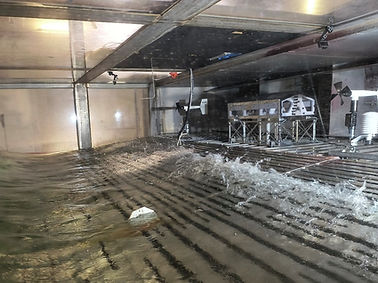
NICHE

Physical Design Testbed
No single existing facility could satisfy the full set of requirements necessary for NICHE's design. So the team used the following four existing facilities (with upgrading, as needed) and built a new wind-only facility at FIU, forming a geographically-distributed Physical Design Testbed (PDT) to conduct experiments across a range of facility configurations within the anticipated design space, allowing for the generation of higher fidelity data to inform the design of NICHE.
Florida International University (FIU) Wind Only Physical Design Testbed (WOPDT)
-
Newly constructed full-scale physical prototype for certain novel components of the full-scale NICHE facility (fans, motors, and flow control devices to be used for simulation of synoptic and transient wind conditions); constructed adjacent to the Wall of Wind
-
Test Types: Configure in both open-circuit and closed-circuit modes to:
-
Conduct high-speed performance tests
-
Develop and test transient wind capabilities at higher speeds
-
Prototype and refine full-scale NICHE equipment in various configurations
-
Perform endurance testing of high-frequency louver system
-
-
Characteristics: Modular design and construction approach to:
-
Allow for simplified reconfiguration between two cross section sizes (approximately 9’ x 14’ and 14’ x 20’) and expansion, if required
-
Operate in open-circuit and closed-circuit modes
-
Allow for reconfiguration between open wall and closed wall or a mix of the two (partially closed flow development section)
-
200 MPH max speed in 9’ x 14’ closed-circuit closed-wall mode; achieves highest practical wind speed in other modes
-
Modular non-synoptic flow control system can be included or removed, as required
-
Modular working section floor that can be modified as required for current and future use cases
-

Closed Circuit

Open Circuit


-
Specifications:
-
16’ fan with boundary layer ingesting blades and low aeroacoustic noise features and direct drive motor
-
Aluminum extruded airfoil type turning vanes in corners 1, 2, and 3
-
Screened expanding corner vanes in corner 4 with integral honeycomb and screen
-
2 stage contraction nozzle with approximately 9’ x 14’ configuration and 14’ x 20’ configuration
-
Reconfigurable aluminum panel working section floor enabling closed wall and open wall arrangements
-
Corners 1 and 2 mounted on rails allowing for closed-circuit and open circuit configurations
-
Debris screens at entrance to Corner 1 and exit of Corner 2
-

-
Findings: Coming soon; testing scheduled to commence in Summer 2025

Oregon State University Large Wave Flume (LWF)
-
Facility was outfit with portable wind generation capability (~60 MPH)
-
Test Types: Conducted wind-only, wave-only and wind-wave tests at two water depths to study scale effects on wind profiles
-
Characteristics: Limited wind speeds (open-circuit setup); freshwater only
-
Benefits: Experiments in the OSU-LWF included conditions at a scale 2x and 3.4x the experiments conducted at UCSD-SOARS and UM-SUSTAIN, allowing a one-to-one comparison between the facilities and identifying the relative effect of the fetch and headspace on wind evolution and wind-wave interactions.
-
Findings: OSU-LWF experiments:
-
Informed the final selection of fetch length for the NICHE facility.
-
Proved wind-generated waves did not affect machine-generated waves, thus wind and wave systems can be designed independently in NICHE.
-
Provided supplemental data to CFD analysis to inform the headspace height.
-
Verified efficiency of NICHE proposed wind/wave generation strategy with no recirculation or significant energy losses.
-
University of California San Diego SOARS
-
Facility enhanced for select tests (increase max wind speed to 90 MPH – 100 MPH, added moisture management features)
-
Test Types: Conducted wave-only and wind/wave tests in closed-circuit configuration with freshwater and seawater
-
Phase 1 (lower wind speeds) to study recirculating (closed-circuit) air flow over the water flume
-
Phase 2 (higher wind speed tests) with modified beach profile to study necessary profile geometry, wave shoaling behavior on these profiles, and recirculating (closed-circuit) air flow over the water flume at higher wind speeds
-
-
Characteristics: Installed 3D anemometer on traversing system to measure 9 points across this section
-
Benefits: Existing wind/wave facility with no retrofitting needed
-
Findings: UCSD-SOARS experiments:
-
Established insensitivity of wave growth and wind profiles to seawater vs freshwater, justifying freshwater use
-
Demonstrated impact of wind on shoaling and breaking waves
-
Confirmed observations at OSU-LWF relative to fetch length, headspace, and selection of instrumentation.
-
Helped inform proposed configuration of slope and platform
-
Supported validation of CFD model to scale up these findings to design NICHE.
-


University of Miami SUSTAIN
-
Facility was used as-is
-
Test Types: Conducted wind/wave tests with freshwater and saltwater spray
-
Characteristics: Installed 3D anemometer on traversing system to measure 9 points across this section
-
Benefits: Existing wind/wave facility with no retrofitting needed
-
Finding: Local pressure and global force coefficients on building model showed negligible differences between freshwater and saltwater spray types; NICHE will use freshwater
University of Florida Boundary Layer Wind Tunnel (BLWT)
-
Facility was used as-is
-
Test Types: Conducted tests under nonstationary and non-neutral wind conditions
-
Characteristics: Limited to low-speed prototype tests of non-synoptic louver system (high-frequency louvers and partial flow blockage used to simulate vortices)
-
Benefits: Complex flow control enabled creation of repeatable, translating vortices using straight-line wind tunnel
-
Finding: Straight-line wind simulators like NICHE can replicate transient flows
